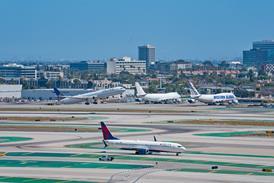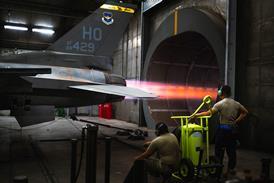Guy Norris/SEATTLE
Boeing is to certificate its proposed ultra-long range 777X variants for 207min extended-range twin-engine operations (ETOPS) for "out of the box" entry into service in September 2003.
The radical move comes as the US Federal Aviation Administration gives its long-delayed green light to 207min ETOPS for current 777-200ER operators, and Boeing pushes towards the launch of the 777X programme, which it expects within the next 10 weeks. General Electric's exclusive deal with Boeing to supply the GE90-115B engine for the new aircraft, has been extended to the end of the first quarter, and a further extension will be needed if the aircraft is not launched by then.
The decision to push the 777X towards instant 207min ETOPS falls into line with the expected ultra-long-haul applications of the aircraft. The 359-seat -300X will fly up to 13,500km (7,300nm), while the smaller -200X will carry 301 passengers up to 16,300km. Clearance for 207min ETOPS closes a mid-Pacific gap that sometimes appears south of the Kamchatka Peninsula when severe weather closes local airports, or volcanic activity erupts in the region.
Closing the gap will give unrestricted operational capability to 777-200ER operators, which would have to apply for 207min clearance "case by case", says the FAA. It would also strengthen the marketing potential of the 777X, which is ranged against the four-engined A340-500/600 family in the battle for dominance on routes to Asia Pacific.
"We know we have to target 207min," says John Roundhill, Boeing vice-president, product strategy and development. Roundhill was speaking just days before the FAA was expected to issue its formal decision on the US Air Transport Association's (ATA) request to extend the 777's ETOPS approval to cover distances 15% greater than those covered by the current 180min ruling.
The ATA move, supported by the Airline Pilots Association and Boeing, has prompted opposition from Airbus Industrie, which says: "The proposed approach falls somewhat short of what we can support at this time."
Meanwhile, Boeing believes that airlines close to signing to launch the 777X derivatives are beginning to accept the exclusive position of the GE90, even though most are not GE90/777 operators. Much of this acceptance is apparently based on the joint efforts of the two companies to "make it look like they had an engine competition", adds Roundhill. "We are prepared with GE to offer the right service programme, spare parts provisioning and a full maintenance cost per hour agreement to try to minimise the impact," he says.
Pending launch by the end of the first quarter, the 777-200X is expected to be renamed the 777-200LR, while the -300X will become the 777-300ER. The first -300ER is due for first flight in December 2002, with certification the following August and deliveries beginning in September 2003. The initial -200LRs are expected to follow "between four and six months later," says Roundhill.
Source: Flight International























